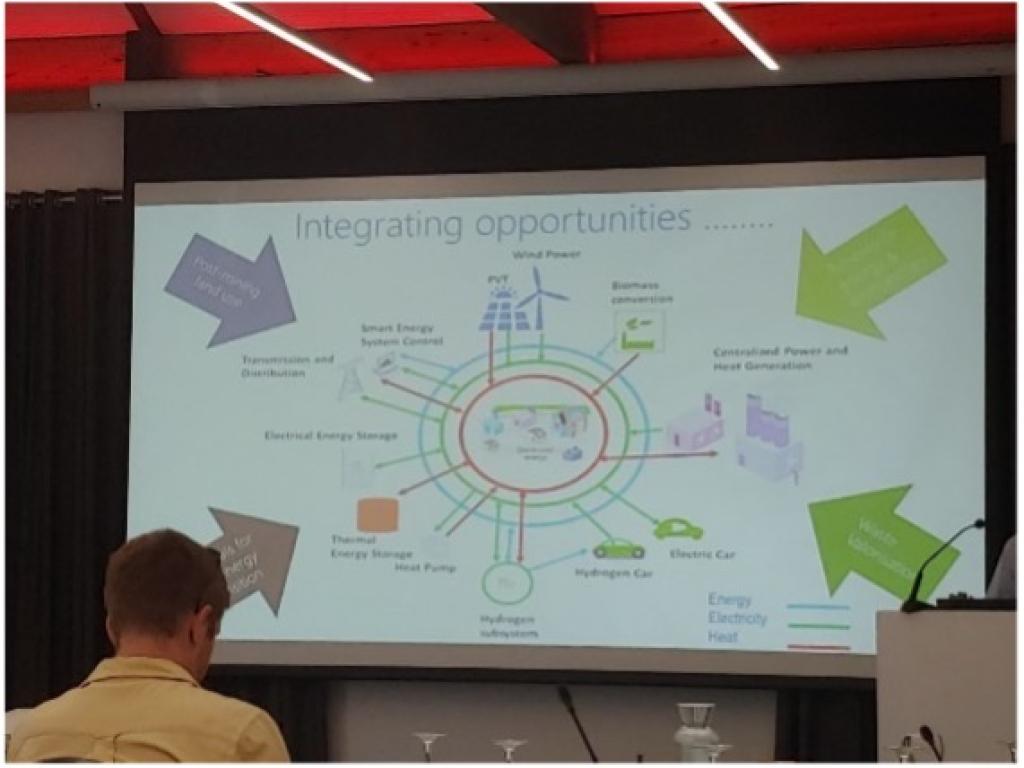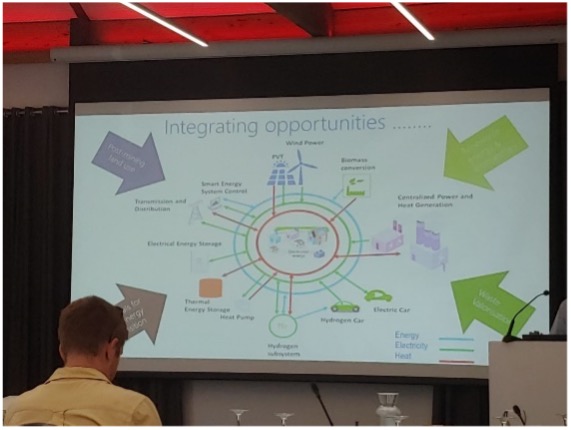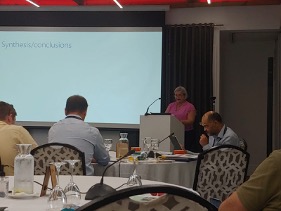Event Review: Towards Resilient Futures DST/NRF Community of Practice II: Use of Fibre-rich Biomass in the Remediation of Degraded Land

Written by Lindsay Moses & Daniel Hertog.
Introduction
The theme of February’s dynamic Towards Resilient Futures DST/NRF Community of Practice II (‘COP’) Workshop Number 4 event, was focused on “Using a Multi-Disciplinary Approach to Explore Opportunities for Economic Diversification in Mining-Intensive Jurisdictions”. The theme of the COP workshops has been the Use of Fibre-Rich Biomass in the Remediation of Degraded Mining Land.

Economics Professor Haroon Bhorat highlighted the role economic considerations can play in the use of fibre-rich biomass in the remediation of degraded mining land. This particularly allowed the room to consider a non-linear approach to economic state models and development when reimagining what an ideal value chain for South Africa looks like in line with its overarching objectives. These considerations were echoed by Minerals to Metals Professor Jenny Broadhurst, who discussed the concept of restoration and regeneration in just transitions and also opened up minds to the importance of having a just transition in the entire value chain. SARChI Chair: Mineral law in Africa, Professor Hanri Mostert offered policymakers direction in articulating what a just transition entails and what the justness of a resource’s value chains may look like by invoking legal tenants of extractive justice.
How can we promote a regulatory environment that will enable sustainable post-mining transitions through the dissemination of our findings?

We were tasked with thinking about this question using the De Bono Method.[1] The De Bono Method is a system of thinking through a subject together six different times, with a different collective focus each time. What follows is a summary of the roundtable discussion between Megan Cole, Megan Bryer, Leezola Zongwe, Fezeka Ntsanwisi and Lindsay Moses.
The discussion began with the first of De Bonos’ hats: the consideration of individuals’ intuition, snap judgment, and emotions about the prompt. There were mixed views about this. Some expressed frustration at the problem as it places the onus on academia and industry to lead the way in making regulations, and may also contradict the purpose and role of the legislature and government departments. Some felt that the role of government was overly elevated in the relationship between stakeholders, and that the wider public as well as civil society are often neglected as meaningful recipients of academic findings. Other relevant stakeholders identified were the physical environment, the land being mined, landowners, rightsholders, mine workers and unions, mining companies and their beneficiaries (such as shareholders and investors), research bodies and organisations in science, law, environment and economy, communities affected by mining communities, and many more depending on how localised a project is.
There was optimism though - especially regarding the fact that there are already regulations in place for the post-mining transition. A sense of urgency was also present, with many feeling that the current pace at which South Africa’s regulatory environment is developing is failing citizens. Getting the ball rolling on comprehensive legislation becomes especially important if catalytic projects are underway that demonstrate benefits to all stakeholders (government, communities etc). From the perspective of NGOs, various organisations and communities, the motivation behind mining companies’ actions (profit) is clear, however, the role of mining companies is yet to be clearly stated by government. As it stands, there are bureaucratic issues which frustrate the process: notably how the government is not able to be cohesive. We often talk of government as a homogenous body, but there are so many stakeholders in government. In fact, the government often competes. Even so, of paramount importance is local government in mining communities as they work with Social and Labour Plans. This can be detrimental because there appears to be a sectoral willingness and interest in cooperation, but regulatory issues hinder this relationship.
Thinking analytically about our current reality
The second prompt informing the discussion was to consider analytically what was known and unknown about the abovementioned theme i.e., what can we glean from our current reality. From this, the question was posed as to who should be the primary driver enabling sustainable post-mining transitions? Instead of taxing mining companies and placing the obligation on the government, should it fall on mining companies directly? It was agreed that legislation already regulates post-mining transitions, but mining companies often fail to comply therewith. This is often because of a failure to ensure proper mine closure plans. Therefore, mine closure planning should commence at the beginning of projects and continue throughout a project’s lifecycle.
Furthermore, there are several research hubs dealing with mine rehabilitation, such as the Intergovernmental Forum on Mining, Minerals, Metals and Sustainable Development and International Institute for Sustainable Development. Such hubs can serve as the primary mechanism through which information regarding a strong regulatory environment enabling sustainable post-mining transitions can be disseminated.
A prime example of how the dissemination of information affects mining companies' response to post-mining transition initiatives is in Namibia where there was a large open pit uranium mine. The mining companies post-mining transition efforts were merely to put a plug on the mine. The Namibian President subsequently deemed the uranium mine a tourist site. This is illustrative of how the type of information and message sent by authorities responsible for overseeing sustainable post-mining transition efforts influence a company’s actions. Therefore, while there are mine rehabilitation programmes, we must think further than what is on paper. We need to go into the field to gain input and experience. As is clear from the aforementioned example, most mining sites are becoming historical sites instead of being rehabilitated. This is rooted in the difficulty of trying to navigate the space of who is involved in the post mining transition and what sustainable outcome should be reached. Government is not monolithic and there is simply insufficient coordination between the various levels of government and departments. Therefore, there needs to be cooperation and strong links between those responsible for overseeing regulations and reaching different outcomes.
A Traffic Light Turns Yellow
The third of De Bono’s hats is one where the room was tasked with considering the current or potential dangers, threats, weaknesses, or negatives posed by the question. Discussants noted that while regulation is good, legislation can hinder sustainability. For instance, legislation hindering solar and wind projects until legislative changes were made last year. A recurring anxiety at the table was the lack of cohesion on what post-transition objectives are between the government as well as the disharmony in guidelines, publications, codes and the like. Some discussants were of the opinion that there was an inherent problem with the neoliberal policy-making efforts of the country. It was proposed there would always be tension in post-mining transitions on the basis that true human well-being and environmental conservation are arguably difficult to reconcile with the growth-driven objectives of capitalism, and thus difficult to prioritise for profit-seeking entities. Mining companies are doing what they have to do, nothing more. Misalignment between actors becomes very clear, along with the need for more stakeholder involvement to achieve truly sustainable outcomes.
It is not clear whether to do that on pragmatic terms or whether to try and shift the ideological underpinnings at play to ask whether excavation is ever profitable considering its impact on others. Participants did consider the role that finances can play and note that with the sustainable finance movement, it is possible when proved to investors that there is money to be made when doing something different (i.e., Total Oil and Gas has now become Total Energies as a result). It has been shown that companies investing in green energy are making more money. Participants note that indeed because of this, we are seeing a move happening. We are now getting to the stage where companies are doing it because big investment groups make companies tremble such as, for example, Norwegian Sovereign Wealth Fund, Harvard etc. There is now greater investing in companies with greener portfolios. The state can and needs to show companies that it is possible to make money and do good for the planet. There is a danger of some stakeholders being excluded, and those who are included in processes not holding others accountable (as can be seen with some NGOs not particularly taking a firmer stand). There is a weakness in the current operation of academia of disciplines not working together or continuing patterns of research silos- academics rarely come together and share research or solutions.
On the Up!
Participants had to then engage the opposite, more optimistic mindset and consider the question in light of existing and potential strengths and opportunities. Participants noted that the fact that legislation already exists is excellent because it has the power to regulate. The role of legislation should be to promote, not hinder sustainable energy transitions. Regulations exist and dictate. Thus, we can dictate sustainability. There is an opportunity for sustainability to be more clearly articulated. There is so much legislation which uses palatable terms, but we must ask at a practical level what we are doing. We must engage various stakeholders to determine what “just” means to them in an African context. We must enable stakeholders to give an idea of what sustainable means. Research can reconcile the opportunity to ensure sustainability. The academic community can highlight this and share research with lawmakers to allow more informed policy formation.
What now?
The fifth prompt required more creativity for the fifth thinking style. Participants were tasked to share innovative ideas in response to the question. Many wonderful solutions arose. Many centred on the role of technological advancements, including considering the ethical use of artificial intelligence (AI) to assist in research. Their issue is an issue in research generally – dense, but pertinent information should be made more digestible to get more stakeholders in on the conversation. The important role of media in information dissemination and meaningful stakeholder involvement was also highlighted. If time and money are not a concern, physically getting people at one table would always be best to get the conversation going. This could shift the arena of knowledge systems and by introducing varied means, languages and ways we begin to tap into indigenous knowledge systems.
The last prompt involved considering the practical application of these ideas and taking the next steps. One important point brought across was that we cannot just place the onus of action on just one stakeholder. First, the authoritative or regulatory bodies disseminating information on post-transition activities must be vigilant in what is promoted, strict on their limitations and transparent in their objectives. Participants noted that media and technology must seriously be considered as it can allow information to be made fun, playful, and interactive. This can get the idea of transition and post-mining transition out there. We must take the conversation to the affected parties to put words into action. To act, we need funding. We must consider whom we approach. Is it just organisations who fund in general or should we consider whether funding should be put on specific parties? We must consider funding avenues. We need resources to set up a plan of action. And then? Then we must act.
[1] Edward De Bono, Six Thinking Hats, 1985.
